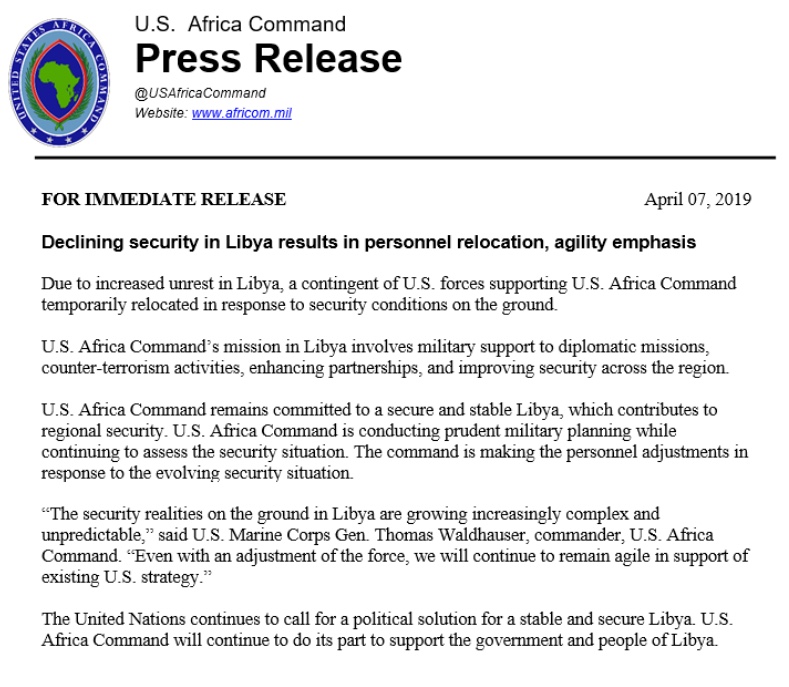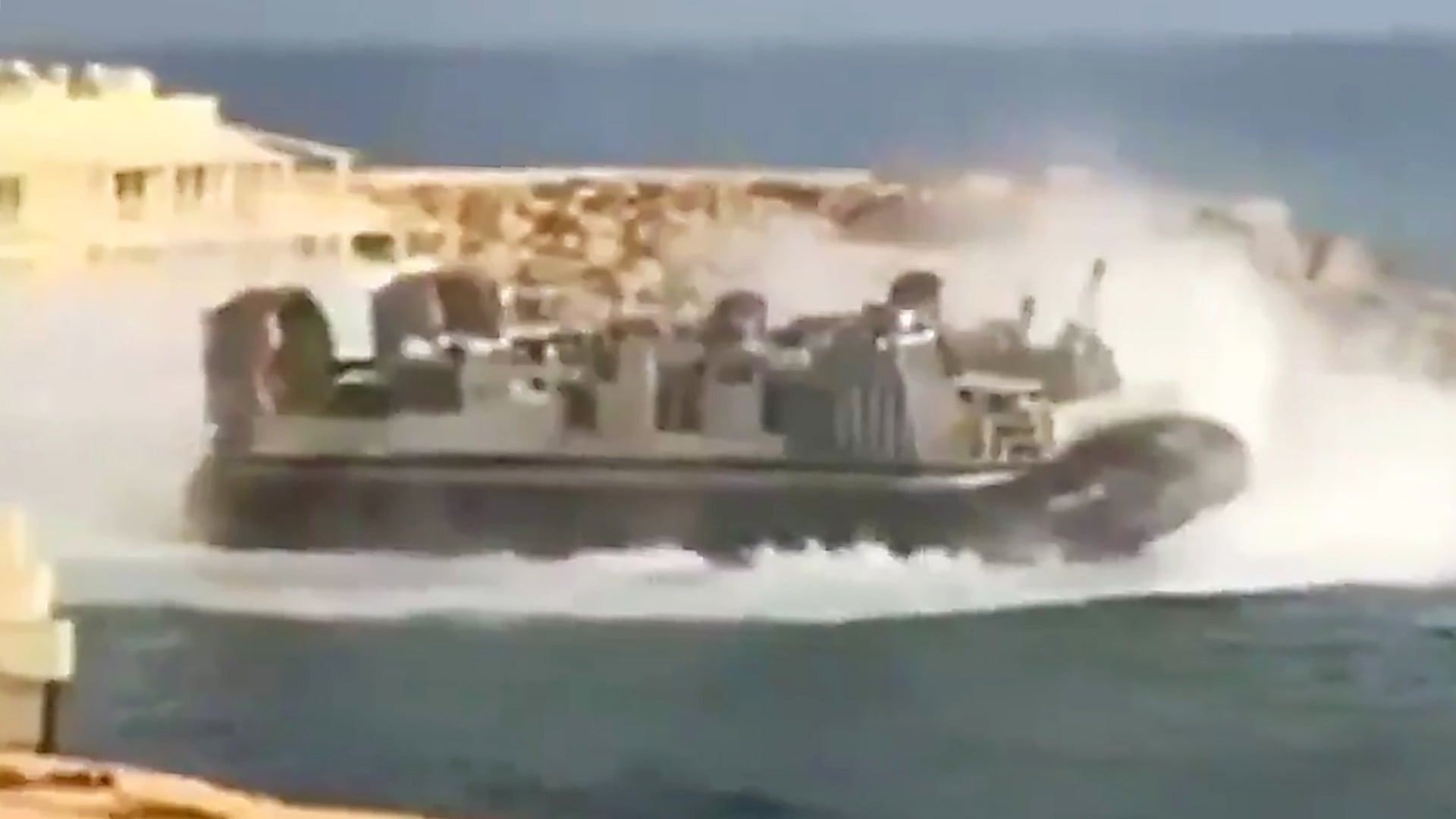Factions of the Libyan National Army (LNA), led by hardline General Khalifa Haftar, have made a thrust into Tripoli and have claimed to have taken control of Tripoli International Airport, which hasn’t been anywhere near fully functional since 2014. The UN-backed Libyan government calls Tripoli home, whereas Haftar has amassed his power largely in the eastern and southern stretches of Libya. Last week, Haftar—who enjoys varying degrees support from the UAE, Egypt, Saudi Arabia, and Russia—ordered his militias to take the Libyan Government’s seat of power in what could be a far more decisive military operation than most expected it to be.
On Saturday, April 6th, 2019 the UN Security Council demanded Haftar stop his military push into Tripoli and to de-escalate the growing military crisis that could see various militia factions pour into Tripoli for what would be another bloody battle for the war-torn city.
Video has now emerged showing U.S. Navy Landing Craft Air Cushion (LCAC) hovercraft approaching and landing on the beach in the town of Janzour, which is located just a few miles to the west of Tripoli. The LCACs supposedly landed, loaded-up, and left the area. U.S. Marines also likely supported the operation by providing additional security.
An official statement from U.S. Africa Command says that personnel were “relocated” as a result of the deteriorating security situation.

LCACs are heavy-load carrying ship-to-shore conveyors capable of accessing unimproved beaches and loading and offloading as much as 75 tons or hundreds of personnel. As such, they are an ideal solution for rapidly evacuating people and material from coastal areas. Using LCACs instead of helicopters also allows for the elimination of the risk posed by shoulder-fired heat-seeking missiles taking down a helicopter—and there are many of those weapons floating around Libya. Considering potentially hostile forces had not reached the coast in that area yet, the threat to the lumbering LCACs was likely low.
It isn’t clear what amphibious ship was launching and recovering the LCACs. The Kearsarge Amphibious Ready Group was operating in the Arabian Sea as of April 1st and there is no indication that it has pushed through the Suez Canal since. A single San Antonio class amphibious transport dock or a Whidbey Island or Harpers Ferry class landing ship dock could be working as the mothership for the LCACs. Using a local land base is more doubtful as Malta would be the closest possibility, but it would stretch the LCACs range unless auxiliary fuel was carried.

The U.S. Embassy in Tripoli was evacuated nearly five years ago via a tense convoy to the Tunisian border backed up by Marine airpower. Still, American forces and diplomatic staff have continued to work in Libya with a special focus on helping the Libyan Government maintain its rickety grip on portions of the country. It was hoped that a conference on holding national elections would be held soon, but that may be in question now as hostile forces sit in a position to potentially expel the Government Of National Accord from their own capital.
Sky News reports that Ghassan Salame, UN special envoy to Libya, stated the following after Haftar had sent his forces pushing toward Tripoli International Airport:
“We have worked for one year for this national conference, we won’t give up this political work quickly.”
Attempts to de-escalate the situation on an official level through negotiations have been rebuffed by Haftar, with the BBC stating:
UN Secretary General Antonio Guterres was in the city [Tripoli] to discuss the ongoing crisis.
Gen Haftar spoke to Mr. Guterres in Benghazi on Friday, and reportedly told him that his operation would not stop until his troops had defeated “terrorism.”
Prime Minister al-Serraj said his government had “extended our hands towards peace” while Gen Haftar had declared a coup.
Meanwhile, Haftar has declared a no-fly-zone over the western half of Libya while government air power has been striking Haftar’s forces, albeit those sorties seem to have done little to slow his forces’ advance into Tripoli.

If Haftar’s operation to take control of Tripoli proceeds, it could lead the country into a deeper fight as western militias work to expel him from the captial or even struggle to hold on to the territory they hold to the west of it. There is also a chance that certain members of the international community could step in militarily with airpower in an attempt to repulse Haftar’s assault, but that could spark a major international crisis considering the various parties involved and their conflicting interests.
Regardless, today’s imagery and news just further underscores how chaotic and unsettled Libya remains over eight years after Operation Odyssey Dawn kicked off.
UPDATE: 6:55am PDT—
A couple of notes worth mentioning:
- The Libyan Government is now saying that they are going to execute a counter-offensive against Haftar’s forces in Tripoli.
- Amphibious Ready Groups to split up often. It is very possible that USS Arlington (LPD 24) and/or USS Fort McHenry (LSD 43) are present in the Mediterranean while the USS Kearsarge (LHD-3) is operating in the Arabian Gulf. In fact, the Arlington was last spotted two weeks ago off Carthage:
- MV-22 Osprey’s brought a high-ranking delegation to Tripoli to meet with the Government of National Accord on March 20th, 2019. This was a very rare event that certainly got the attention of General Haftar.
UPDATE: 5:30pm PDT—
Haftar’s forces have made the following statement about the no-fly-zone:
“We are implementing a #NoFlyZone over west #Libya, any military jet will be considered a target as well as its takeoff location. This includes Aerial photography and excludes commercial flights.”
Meanwhile, LNA fighter aircraft based in the eastern part of the country executed airstrikes near Tripoli in support Haftar’s ground forces’ push into the center of the metropolis. There are reports that the Libyan National Army is moving road-mobile SAM systems into position near Tripoli to enforce its no-fly-zone and to keep international aircraft out of the area. The U.S. and its allies often fly reconnaissance missions over the area with turbprop manned aircraft and drones.
The UN has repeatedly tried to broker a ceasefire, even just a temporary one to get civilians out of Tripoli, but Haftar isn’t interested. Even mentioning the strongman directly in a joint statement by the UN Security Council was shot down by Russia.
We will update this post with new details as more information comes available.
Contact the author: Tyler@thedrive.com
